4 Myths About Clubfoot
The birth of a child is a moment of unparalleled joy for families, but when clubfoot enters the equation, it introduces unexpected challenges. The journey ahead may seem daunting, compounded by pervasive misconceptions and myths surrounding this congenital condition. In this blog, we will delve into the intricacies of clubfoot, debunking prevalent myths, and providing a nuanced understanding to support families on this complex journey.
What is Clubfoot?
Clubfoot is a congenital condition that manifests as an inward or twisted position of one or both feet, making it challenging for the child to place the sole of their foot flat on the ground. The severity of clubfoot varies, but what remains constant is the impact it has on families, often intensified by misinformation and societal myths.
Myths About Clubfoot
Myth 1: Major Surgery is the Only Solution
A widespread misconception regarding clubfoot is the belief that major surgery is the sole solution for correction. While surgical intervention may be necessary in some cases, the Ponseti method stands as the prevailing and highly successful non-surgical approach. Devised by Dr. Ignacio Ponseti, this method involves a series of gentle manipulations and the application of casts. In certain instances, a minor procedure to lengthen the Achilles tendon may be required. The Ponseti method offers a less invasive and more successful alternative to major surgical procedures, highlighting the importance of tailored, individualized treatment plans.
Myth 2: You’re Alone in This
The emotional toll of a clubfoot diagnosis is often exacerbated by a sense of isolation. However, it is crucial to understand that families are not alone on this journey. A robust network of support groups, compassionate medical professionals, and organizations are committed to assisting families in navigating the multifaceted challenges associated with clubfoot. Connecting with others who have traversed similar
paths provide a valuable support system, offering guidance, empathy, and a shared sense of understanding.
Myth 3: Clubfoot Will Affect Your Child for Life
Anxiety often deepens when parents believe that clubfoot will cast a lifelong shadow over their child’s existence. Contrary to this belief, with timely and appropriate treatment, children with clubfoot can lead entirely normal lives. The Ponseti method, when administered promptly, facilitates the correction of the foot’s alignment, enabling children to engage in regular activities, and sports, and lead healthy, active lifestyles. Parents must embrace the hope and optimism that effective treatment brings, focusing on the possibilities rather than the limitations.
Myth 4: This is Your Fault
Parental guilt and self-blame are common emotional responses when faced with a child’s health condition. However, it is imperative to dispel the myth that clubfoot is a result of parental actions or negligence. Clubfoot is a congenital condition, developing before birth and not influenced by anything the parents did or did not do during pregnancy. Redirecting energy towards supporting the child’s healing journey becomes possible when parents understand that clubfoot is beyond their control.
The Importance of Early Intervention
Timely intervention is pivotal in the successful treatment of clubfoot. Parents should be proactive in seeking medical attention for their child as soon as the condition is identified. Pediatric podiatric specialists, well-versed in the nuances of clubfoot treatment, play a pivotal role in guiding families through the necessary steps. Early detection and intervention significantly contribute to favorable outcomes.
Contact Us for Treatment and Help
If you find yourself navigating the complexities of clubfoot, reaching out for support and professional guidance is essential. Pediatric podiatric specialists, support groups, and organizations specializing in clubfoot are invaluable resources. Connecting with these resources early in the journey equips families with the knowledge and support necessary to navigate the challenges ahead successfully.
Embracing the Journey: Beyond Treatment
Beyond the medical aspects of treatment, it is crucial to recognize the emotional toll that clubfoot can have on both parents and the child. Seeking psychological support, whether through counseling or participation in support groups, can help families cope with the emotional challenges that may arise. Understanding that healing extends beyond physical correction is crucial in fostering a holistic approach to the well-being of both the child and the family.
Dispelling myths about clubfoot is an essential step in empowering families to face the challenges associated with this condition. By understanding the realities of clubfoot, embracing accurate information, and seeking support, families can navigate this intricate journey with resilience and hope.
Early intervention, a comprehensive support system, and a holistic approach to healing are key elements in ensuring the best possible outcome for children born with clubfoot. Remember, you are not alone, and there is a community ready to offer guidance, empathy, and support throughout this journey.

